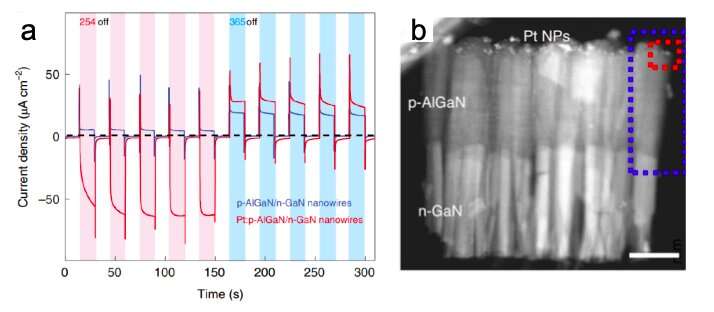Semiconductor p-n junctions are boundaries between two types of semiconductors (i.e., p-type and n-type semiconductor materials). These junctions are crucial components of many modern electronic devices.
So far, typical p-n junction-based devices have only allowed current to flow in one direction, a physical characteristic that is associated with all semiconductors. However, this significantly limits their potential for developing some types of devices, such as multi-color detection, advanced imaging and optical communication tools.
Researchers at the University of Science and Technology of China have recently demonstrated that the direction in which photocurrent flows within p-n heterojunction devices can be controlled using different wavelengths of light. Their paper, published in Nature Electronics, could ultimately pave the way toward the development of new optoelectronic and electronic devices.
“Inspired by the previous discovery of novel structures or device designs, for example, the adoption of multi-junction or tandem architecture, to expand the functionalities beyond a single p-n junction, we were aiming to renovate the p-n junctions for new functionalities,” Haiding Sun, one of the researchers who carried out the study, told TechXplore. “A combination of the photoelectric effect and p-n junction semiconductors has often been used to build classical solid-state photodetectors. However, these systems’ detection capability is fundamentally constrained to a certain spectrum range, since they always generate photocurrent flows in the same direction (i.e., a unipolar photoresponse).”
The final objective of the recent paper by Sun and his colleagues was to develop new p-n heterojunction devices in which the direction of photocurrent can be switched using different wavelengths of light, as this would allow them to create new and more advanced photodetectors. In more specific terms, the team wanted achieve a so-called ‘dual-polarity photoresponse’ in p-n heterojunctions to enable multi-band or spectrally distinctive photodetection.
“The human eye acts as a natural photosensor or photodetector with high sensitivity to different light (or color),” Sun explained. “However, for man-made, single-semiconductor-material-based detectors, it is difficult to distinguish even between two different wavelengths. In other words, it is challenging to build a photodetector that possesses both spectrally distinctive and broadband responsive features; distinguishing spectral bands without sacrificing the sensitivity/selectivity is particularly challenging in the ultraviolet band, where most materials show strong ultraviolet absorption.”
When they are exposed to light with a wavelength that is equal or shorter than the optical bandgaps of the materials they are made of, photodetectors based on conventional p-n junctions typically only exhibit a so-called unipolar photocurrent response; this only allows electric currents induced by light to flow in one direction. To overcome this limitation, Sun and his colleagues devised a new strategy that enables a dual-polarity photocurrent response, allowing engineers to switch the direction of photocurrent in n-p junctions.
They used this strategy to create a light-detection electrochemical cell based on p-AlGaN/n-GaN nanowire heterojunctions placed on a conductive silicon substrate. This device exhibited a distinctive photoresponse, with a reversed polarity under different illumination wavelengths.
“Our newly constructed light-detection electrochemical cell operates under a combination of physical processes (photoelectric conversion and carrier transport in single p-n junction) and chemical process (redox reaction on nanowire surface), enabling a fast and easy way to distinguish different spectral bands by simply verifying the polarity of photocurrent,” Sun said. “It thus offers a new degree of freedom to manipulate the carrier transport and thus current flow in semiconductor devices.”
Sun and his colleagues were able to observe bidirectional photocurrent behavior in their device after it was exposed to light with two wavelengths (i.e., 254 nm and 365 nm). The two wavelengths triggered opposite redox reactions, the hydrogen evolution reaction (HER) and oxygen evolution reaction (OER) on the nanowire/electrolyte interface, inducing a reversal in the polarity of the photocurrent.
The findings could have important implications for the development of new optoelectronic technologies. In fact, Sun and his colleagues showed that bidirectional current can be enabled in p-n heterojunctions, which means that these interfaces could be used to create switchable light imaging, optical communication and filter-less color discrimination tools. In addition, the device they created can operate in water or in aqueous environments without requiring sophisticated packaging or integrations, and could thus be ideal for the creation of systems that work underwater or inside biological systems.
“Our architecture expands the functionalities of classic semiconductor device structure for multifunctional applications,” Sun added. “The next step for our research would be the implementation of the light-detection electrochemical cell in the bio-related environment for bio-sensor or medical applications.”
MXene-GaN van der Waals metal-semiconductor junctions for high performance photodetection
More information:
Danhao Wang et al, Bidirectional photocurrent in p–n heterojunction nanowires, Nature Electronics (2021). DOI: 10.1038/s41928-021-00640-7
2021 Science X Network
Citation:
A strategy to manipulate photocurrent direction in p-n heterojunction nanowires (2021, October 12)
retrieved 13 October 2021
from https://techxplore.com/news/2021-10-strategy-photocurrent-p-n-heterojunction-nanowires.html
This document is subject to copyright. Apart from any fair dealing for the purpose of private study or research, no
part may be reproduced without the written permission. The content is provided for information purposes only.
